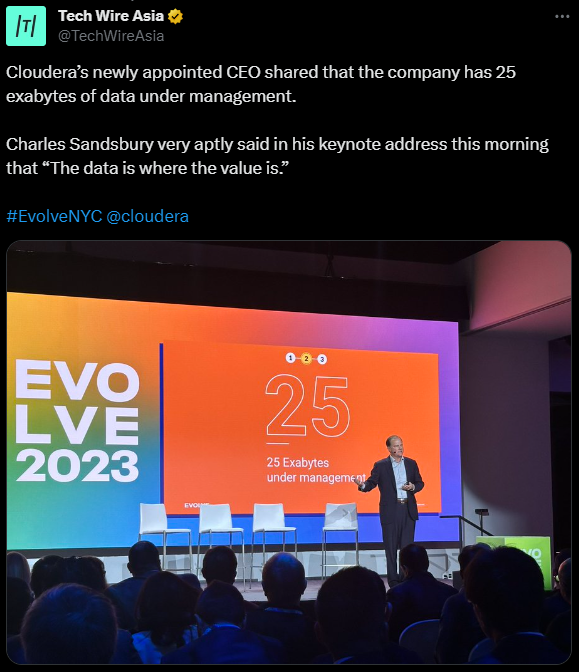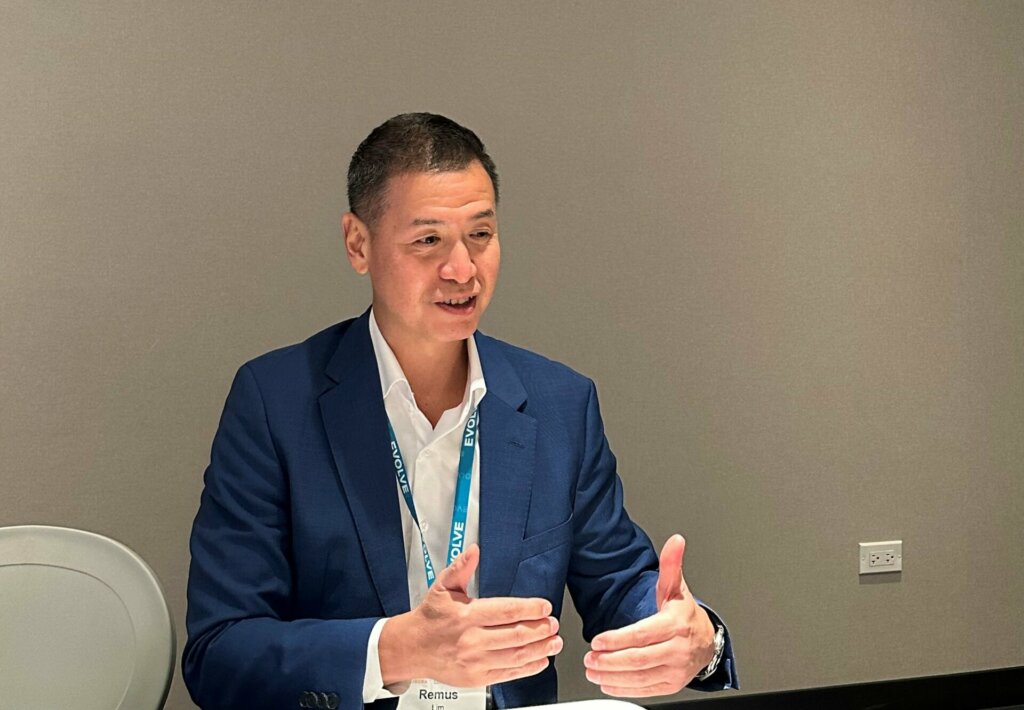Cloudera: APAC shines, and it’s not all gloom and doom in China

- While APAC is flourishing, Cloudera sensed more challenges from North Asia, particularly with the geopolitical situation between China and the US.
- TechHQ sat down with Remus Lim, Cloudera’s VP of Asia Pacific and Japan, to discuss AI adoption, hybrid cloud, and the region’s prospects.
- Lim underscored the challenges companies faced in China, emphasizing how geopolitical tensions with the US have led to a governmental shift away from American products.
Since it was founded in 2008, Cloudera has been a dominant force in the Big Data field. Managing 25 exabytes of data today, the company effectively addresses data management challenges in public and private clouds, empowering customers to handle and derive value from their data efficiently.
Patrick Moorhead aptly wrote in an article for Forbes that the evolution of Cloudera is evident across its versions, from Cloudera 1.0, dedicated to constructing an open source enterprise data platform, to Cloudera 2.0, which brought together Hortonworks and Cloudera to expedite the journey to a hybrid cloud. Finally, Cloudera 3.0 marked a significant milestone by establishing the first genuine hybrid, multi-cloud data platform.
Today, the platforms provided by Cloudera are more timely than ever, considering how data has been multiplying at an astonishing rate. The surge urgently demands efficient data management across organizations and industries, and Cloudera lets customers manage their proprietary data across private and public cloud environments.
After all, in a post-ChatGPT era, generative AI and large language models (LLMs) are only as good as the data they’ve been trained on. On average today, nine out of ten of the largest global companies in various industries “trust Cloudera with their data assets,” according to CEO Charles Sansbury. That figure resulted in 25 million terabytes of data being managed with Cloudera solutions.

25 exabytes – that’s playing with th ebig boys. Source: Tech Wire Asia on X
Although the company does not specialize in generative AI today, its Cloudera Data Platform (CDP) and related tools have been crucial in supporting the data infrastructure needed for generative AI applications in enterprises.
During Cloudera’s recently concluded Evolve conference held in New York, TechHQ sat downwith Remus Lim, VP of Asia Pacific and Japan, discussing AI adoption among enterprises, the prominence of hybrid cloud, and the region’s prospects in the near future.
The interview has been edited for length and clarity.
THQ: What’s your role, and how has it been since you assumed it?
I’ve been managing this role for almost two years now. ASEAN is the largest territory across the Asia Pacific (APAC), and there have been various challenges and different contexts from a regional perspective. For context, APAC in the Cloudera context comprises ASEAN, India, China, Korea, Japan, and ANZ (Australia and New Zealand). We separated Indonesia from ASEAN. We have a reasonably big team in Indonesia, as we do quite a bit of business in the country, with the largest telco being our biggest customer. In fact, all the telcos and banks in Indonesia are our clients.
In terms of the last year, there were more challenges from North Asia, particularly with the geopolitical situation between China and the US. The Chinese market, in particular, has been facing a lot of uncertainty because of the geopolitical and political situation and the economic conundrum. On the geopolitical front, the Chinese government is encouraging local enterprises not to use US products. It’s not a law, but it’s recommended.

Remus Lim, VP Asia Pacific and Japan, Cloudera.
So, we are seeing a few headwinds over there. As for the rest of the region, Japan and Korea are substantial manufacturing countries. We know the sector is in a slump right now, with companies being more conservative and pulling back on spending. On top of that, the strong US currency across our region needs to be helping. In a nutshell, geopolitical and economic situations, as well as currency, are the key issues.
But having said that, our key customers are still investing and expanding fast despite delayed expansion plans. Hopefully, next year, things will be better.
THQ: Is China a big market for Cloudera? If yes, how are you circumventing the downturn?
China is a big market. If I ranked them, it would be second. We’re very pragmatic. We continue to sell our values and solutions, and at the end of the day, we will convince customers that we are providing them with a platform. We are not building an IP; we are not taking your data. It is a platform that merely helps you to manage the data.
So, it is challenging. Specific organizations will be okay, but some will not. We have some of the largest organizations in our portfolio, like Shanghai Pudong Development Bank (SPDB), a state-owned bank. Though they are under pressure, they are still investing in us. On the flip side, with telcos like China Mobile, that has been tougher. We do have partnerships with local cloud providers like Alibaba though.
THQ: Your chief revenue officer, Frank O’Dowd, mentioned that the recently concluded third quarter was APAC’s biggest. Could you elaborate on that?

Source: LinkCXO Global Pvt. Ltd. on X
The success was due to three key regions, out of which two saw a record-breaking quarter: ANZ. India specifically grew by over 400% because we closed a huge deal. But it has not just been for this quarter. This year, India has been doing exceptionally well, and in the last quarter, we closed a deal with PhonePe, an Indian Fintech company.
One of the critical things PhonePe wanted out of us was the assurance that Cloudera should not go 100% on the cloud, because they also believed in on-premise strategy and wanted to ensure we did, too. That resonated well with us, so it worked well in our favor.
THQ: Does that mean that the momentum for Cloudera still lies within the telco and the financial industry?
As you can imagine, our most significant sector is customer, which has a lot of complex data. That is typically the financial, telco, government, and manufacturing sectors. These days, there are more vested interests in smart manufacturing and autonomous driving, and we are seeing that in China as well. Take SAIC-Volkswagen Automobile, the Sino-German joint venture operated by SAIC and Volkswagen Group, one of China’s oldest automotive joint ventures.
Cloudera is aiding SAIC Volkswagen in constructing a vehicle data monitoring platform to meet regulatory requirements for smart vehicle data in its Internet of Vehicles (IoV) business. Deploying CDP has resulted in substantial performance enhancements, reducing costs and optimizing data operations efficiency. The implementation has led to a 67% reduction in storage space needs, enhancing vehicle monitoring efficiency and optimizing vehicle data management for SVW.

Remus Lim in conversation with THQ. Photo: TechHQ.
THQ: Enterprises are still wary when it comes to deploying generative AI. What are the narratives like on that in the APAC?
OCBC, one of the largest financial institution in Southeast Asia based in Singapore, is one of the early adopters of AI and machine learning. It started five years back, setting up an AI Lab and recruiting the right people. Today, it has around 200 data scientists. The challenge, however, is that not all banks invest that way. So when we take the story other banks in Japan, Korea, and other countries, they’re all trying to do something.
But the challenge is that they don’t have the skills, so they hit a brick wall before starting. You need to have a vision and build a foundation. So, for customers who are not at that stage, it is difficult for them to get up there. But AI, in general, has been around for a while, including machine learning. The typical use case for banks is fraud detection, so, there’s a maturity curve.
Generative AI, however, is something new, and most organizations will need to figure out how to use it.
THQ: But have enterprises grasped how data should be collected, cleaned, and managed overall for them to move towards utilizing it for generative AI?
Absolutely. I have been in the business intelligence or data analytics area for over ten years, and it was the same conversation back then. It is just now getting bigger because of the size of the data and the volume we hold today. So yeah, you’re right; people are still talking about silos, inconsistency, and the readiness to merge. That challenge is still there, and the ongoing conversation will not change because technology keeps evolving.
That is perhaps why we adopt an open ecosystem to provide solutions – because there is no such thing as “one size fits all .” It is essential for us also to commit ourselves to the open source environment so that all these ecosystems can work together.
THQ: What do you see as the biggest priority for the region, and what sort of customers is Cloudera targeting going forward over the next year?
For us, it’s about moving up the value chain. When we started, we were on Hadoop, and when Cloudera and Hortonworks merged, we came up with a new product called CDP to re-architect the whole thing, modernizing the entire stack. So it became a single architecture, on-prem or on the cloud, which is more of a cloud-native architecture, providing us the agility and the scalability using separation of compute and storage. So we started that.
In the past three years, we’ve been trying to make sure that our customers move to CDP from legacy, and we have crossed that hurdle. The next thing is, how do I then get our customers to tap onto what we promise, because there is a lot more potential that they can push, like how OCBC had moved from CDH (Cloudera’s 100% open source platform distribution, including Apache Hadoop, built specifically to meet enterprise demands) to CDP.
Then, we found out that they had a big plan for AI. When they started moving to CDP, we introduced them to data services on CML (CDP Machine Learning), and that’s when the whole thing flew.
They began to see the value of CML, which is data services, and because of the whole ecosystem, they could plug in Hugging Face and LLM models and create the entire ecosystem into the CML as the base. So that makes a lot of value for them. You’d need to have trusted data to have trusted AI. The foundation of that is CDP, which manages the trusted database.
THQ: It is a very competitive landscape today. How does Cloudera sets itself apart from the rest of the lot, including hyperscalers
We are in a competitive environment; we cooperate and compete. There are undoubtedly many rivals, and once we realize that, we will be able to understand how to operate and go into the market. Our key differentiator is the fact that Cloudera is genuinely hybrid.
If you look at all our competitors, everyone is eager to jump on top, and their strategy is 100% cloud, whereas we are hybrid. So we are in a unique position where we provide all rights: on-premise and cloud. Not just cloud; we even support multi-clouds like AWS, Azure, and others. So we don’t get customers locked in. From that perspective, we are in a very unique position.
THQ: What are Cloudera’s plans for the region?
We provide the capability to our customers to build because we’re still a platform. We are also building those capabilities into our platform. Our challenge was trying to move our legacy into the new platform. Now that has happened, how can we propel? So there is that.
We are building a natural language LLM where developers can use natural language to submit queries. So that is in the works and should be out soon. That will enhance our product with generative AI capabilities, and that helps to improve the operational efficiency for customers.










